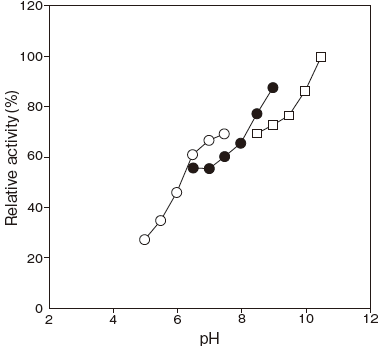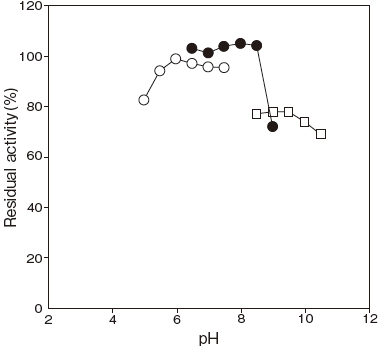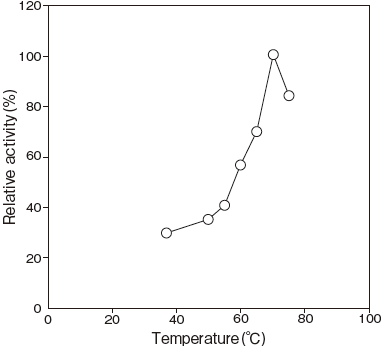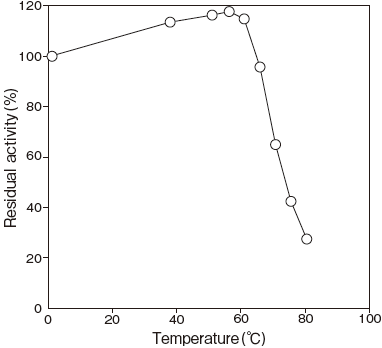NAD SYNTHETASE [NADSⅡ]
from Geobacillus stearothermophilus
(Deamido–NAD+ : ammonia ligase (AMP–forming) , EC 6.3.1.5)
(NAD synthase)
Deamido–NAD+ + ATP + NH3 → NAD+ + AMP + PPi
Preparation and Specification
- Appearance
- : White amorphous powder, lyophilized
- Specific activity
- : More than 1.00 U/mg solid
Properties
- Substrate specificity
- : See Table 1
- Molecular weight
- : 50 kDa (gel filtration)
25 kDa (SDS–PAGE)
- Michaelis constants
- : Deamido–NAD 2.4 × 10-5M
ATP 4.3 × 10-5M
NH3 2.16 × 10-3M
- Isoelectric point
- : pH 5.2 ± 0.2
- Optimum pH
- : 9.0–10.5Figure 1
- pH stability
- : 6.0–9.0 (37℃, 15 min) Figure 2
- Optimum temperature
- : 70℃ (Tris–HCl buffer) Figure3
- Thermal stability
- : Stable at 60℃ and below (pH 7.5, 10 min) Figure4
- Effect of metal ions
- : See Table 2
- Effect of detergents
- : See Table 3
Applications for diagnostic Test
This enzyme is useful for enzymatic determination of ATP, ammonia, urea or creatinine when coupled with creatinine deiminase.
This enzyme is suitable for enzymatic cycling method when coupled with dehydrogenase and diaphorase (T–06) .
Please refer to an information 3α–hydroxysteroid dehydrogenase (T–58)
Table 1. Substrate specificity
| Substrate (1mM) | Relative activity (%) |
|---|---|
| NH4CI | 100 |
| L–aminoacids (Leu, Arg, Lys, Ileu, Tyr, Ala, Glu, Gln, Asn, Gly, Ser) |
0 |
| Azaserine | 0 |
| Urea | 0 |
| Uric acid | 0 |
| Creatinine | 0 |
| Creatine | 0 |
| Tris | 0 |
| Good's buffers | 0 |
Table 2. Effect of metal ions on NADS Ⅱ activity
| Metal ion (1mM) | Relative activity (%) |
|---|---|
| None | 100 |
| NiCl 2 | 1.1 |
| BaCl 2 | 106.0 |
| SnCl 2 | 99.8 |
| AlCl 3 | 95.6 |
| CdSO 4 | 2.4 |
| MnCl 2 | 18.2 |
| CuCl 2 | 3.6 |
| ZnCl 2 | 5.8 |
| CoCl 2 | 94.2 |
| MgCl 2 | 102.0 |
| CaCl 2 | 103.0 |
| HgCl 2 | 0.3 |
Table 3. Effect of detergents on NADS Ⅱ activity
| Detergent (0.1%) | Relative activity (%) |
|---|---|
| None | 100 |
| Adekatol SO–120 | 108.2 |
| SO–145 | 106.9 |
| Brig 35 | 107.5 |
| Cation DT–205 | 10.5 |
| FB | 11.8 |
| Cetylpyridinium chloride | 1.6 |
| Sodium dodecyl sulfate | 2.3 |
| Tween 80 | 102.3 |
| Cholic acid | 105.6 |
| Cetyltrimethyl ammonium chloride | 4.2 |
| Span 85 | 104.6 |
| Sodium laurylbenzene sulfonate | 6.5 |
Assay
Principle
-
The assay is based on the increase in absorbance at 340 nm as the formation of NADH proceeds in the following reactions:
| NADS Ⅱ | ||
| Deamido–NAD+NH4++ATP | → | NAD++AMP+PPi |
| Mg2+ | ||
| 3α–HSD Ⅱ | ||
| NAD++Cholic acid | → | 3 –Oxo–cholic acid+NADH |
NAD:Nicotineamido adenine dinucleotide
ATP:Adenosine triphosphate
Unit definition
-
One unit is defined as the amount of enzyme which converts 1 μmole of deamido–NAD to NAD+ per minute at 37℃ under the conditions specified in the assay procedure.
Reagents
- Reaction mixture
1 M Diethanolamine–HCl buffer pH 9.5 0.20 ml 20 mM Deamido–NAD solution 0.20 ml 0.2 M ATP solution pH 7.0 0.15 ml 0.1 M MgCl2 solution 0.30 ml 0.1 M NH4Cl solution 0.30 ml 200 U/ml 3α–HSD Ⅱ solution 0.20 ml 50 mM Sodium cholate solution 0.40 ml Distilled water 0.25 ml
- Reaction stopper
0.3 M EDTA solution pH 9.5
EDTA: Ethylenediamine tetraacetic acid - Enzyme dilution buffer
20 mM Bicine–NaOH buffer pH 8.5 - Reagents
Diethanolamine:FUJIFILM Wako Pure Chemical CorporationDeamido–NAD: Oriental Yeast Co., Ltd.
Special grade #093–03115
ATP: Kyowa Hakko Co., Ltd.
3α–HSD Ⅱ: Asahi Kasei Pharma Corporation #T–58
- Sodium cholate: Tokyo Kasei Kogyo Co., Ltd.
Special grade #C 0325EDTA (2Na・2H2O) : KISHIDA CHEMICAL Co., Ltd.#060–29133Bicine: Dojindo Laboratories #347–03282
Enzyme solution
-
Accurately weigh about 20 mg of the sample and add enzyme dilution buffer to make a total of 20 ml. Dilute it with enzyme dilution buffer to adjust the concentration to within 0.3–0.7 U/ml.
Procedure
- Pipette accurately 2.0 ml of reaction mixture into a small test tube and preincubate at 37℃.
- After 5 min, add exactly 50 μl of enzyme solution and mix to start the reaction at 37℃.
※ In the case of a test blank, add 50 μl of enzyme dilution buffer in place of enzyme solution. - At 5 min after starting the reaction, add 1.0 ml of the reaction stopper to stop the reaction.
- Measure the absorbance at 340 nm.
0.130Abs ≦ △A = (As−Ab) ≦ 0.390 AbsAbsorbance sample : As blank : Ab
Calculation
-
Activity (U/mg of powder) = {(△A/5)/6.3} × 3.05/0.05 × 1/x
6.3: millimolar extinction coefficient of NADH at 340 nm ( cm2 /μmole)5 : reaction time (min) 3.05 : final volume (ml) 0.05 : volume of enzyme solution (ml) X : concentration of the sample in enzyme solution ( mg/ml)
Storage
-
Storage at−20℃ in the presence of a desiccant is recommended.
NADS Ⅱ 活性測定法 (Japanese)
試薬液
- 反応試薬混合液
1.0 M DEA (Diethanolamine) –HCl 緩衝液 pH9.5 0.20 ml 20 mM デアミド–NAD (NaNAD) 溶液 1) 0.20 ml 0.2 M ATP 溶液 pH7.0 2) 0.15 ml 0.1 M MgCl2 溶液 0.30 ml 0.1 M NH4Cl 溶液 0.30 ml 200 U/ml 3α–HSD Ⅱ溶液 3) 0.20 ml 50 mM コール酸ナトリウム溶液 0.40 ml
-
精製水 0.25 ml 1) : 20mM デアミドNAD 溶液
デアミドNAD 133 mg (純度換算) を精製水10 ml で溶解する。2) : 0.2M ATP 溶液 pH7.0
ATP1.21g を精製水8ml に溶解した後、4N
NaOH でpH7.0 に調整し、精製水で全容を10ml とする。3) : 200U/ml 3α–HSD Ⅱ溶液
3α–HSD Ⅱ 2,000U を精製水10ml で溶解する。
- 反応停止液
0.3 M EDTA 溶液 pH9.5 - 酵素溶解希釈用液
20 mM Bicine–NaOH 緩衝液 pH8.5 - 試薬
DEA (ジエタノールアミン) :富士フイルム和光純薬製 特級 #093–03115デアミドNAD:オリエンタル酵母製
ATP (アデノシン・三リン酸・2Na・3H2O ) :協和発酵製3α–HSD Ⅱ:旭化成ファーマ製 #T–58
コール酸ナトリウム:東京化成工業製 特級 #C 0325EDTA (エチレンジアミン四酢酸・2Na・2H2O ) :キシダ化学製 #060–29133Bicine (ビシン) :同仁化学製 #347–03282
酵素試料液
- 検品約20mg を精密に量り、酵素溶解希釈用液で溶解して全容20ml とする。
その液を酵素溶解希釈用液で0.3–0.7U/ml 濃度となるように適宜希釈する。
測定操作法
- 小試験管に反応試薬混合液2.0ml を正確に分注し、37℃で予備加温する。
- 5 分経過後、酵素試料液50 μ1 を正確に加えて混和し、37℃で反応を開始する。
※ 盲検は酵素試料液の代わりに酵素溶解希釈用液50μ1 を加える。 - 5 分経過後、反応停止液1.0ml を加えて混和し、反応を停止する。
- 340nm における吸光度を測定する。
求められた吸光度変化の試料液はAs、盲検液はAbとする。
0.130Abs ≦ ΔA = (As−Ab) ≦ 0.390 Abs
計算
活性 (U/mg) = {(ΔA/5)/6.3} × 3.05/0.05 × 1/x| 6.3 : | NADH の340nm におけるミリモル分子吸光係数
(cm2 /μmole) |
| 5 : | 反応時間 (min) |
| 3.05 : | 反応総液量 (ml) |
| 0.05 : | 反応に供した酵素試料液量 (ml) |
| X : | 酵素試料液中の検品濃度 (mg/ml) |







